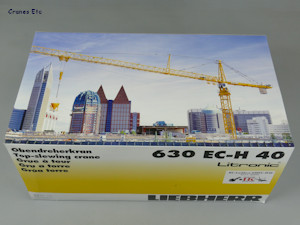 |
| Liebherr sleeve
encloses the trays HK sticker shows this is conversion.
|
 |
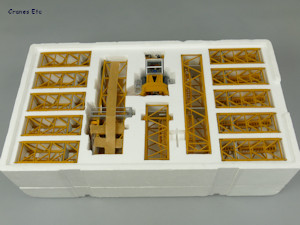 |
| As unpacked, middle
tray holds the mast sections, climbing frame and cab.
|
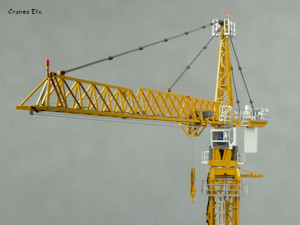 |
| Shortest possible
configuration. |
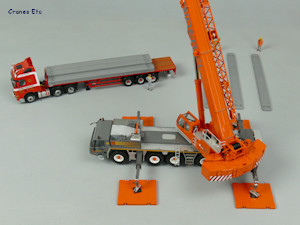 |
| Starting to lay
the track.. |
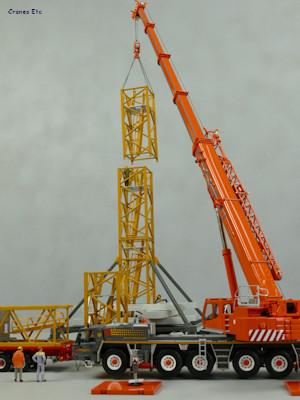 |
| Mast being built.
|
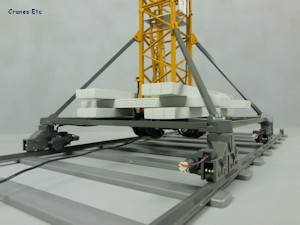 |
| Bogie motors are
realistically small.. |
|
|
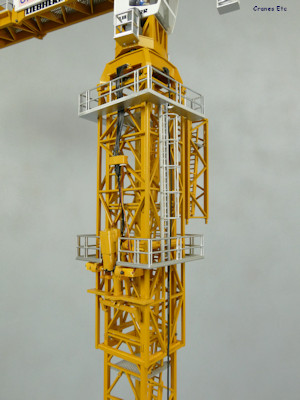 |
| Climbing cage has
the top platform and ladder missing from the base version
of the model. Climbing ram looks good. |
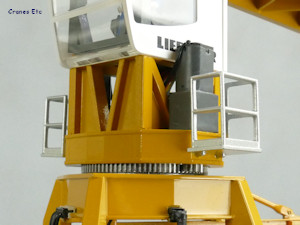 |
| Slewing motors
are a realistic size. Toothed slewing ring. |
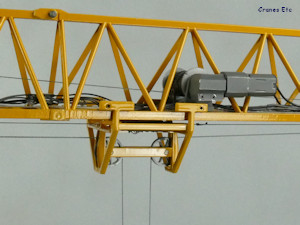 |
| Trolley winch
motor is impressively small. The connection bolts between
jib sections are much improved and provide better rails
for the trolley and jib profile. |
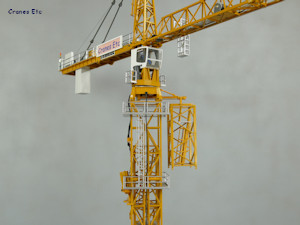 |
| Halfway through
the climbing process. |
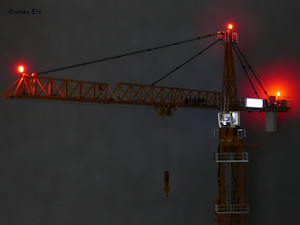 |
| Warning lights
flash at irregular intervals. |
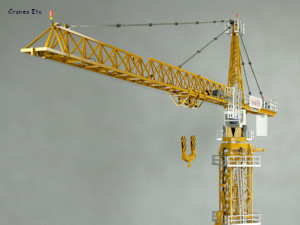 |
| Excellent profile.
Heavy lift mode. |
|

At the BAUMA exhibition in 2007 a prototype of this 1:50
scale model by Conrad was presented, and it entered production
a year later.
The real 630 EC-H 40 has a maximum capacity of 40 tonnes
at 15m radius, and can be configured with jib lengths of
up to 80m. It can also free stand to a height of 80m.
This model is a radio controlled conversion of the original
Conrad model by HK-Funktionsmodellbau. It includes
almost all the options available including lighting, working
climbing cage and rail mounted.
Packaging
The model box is in the typical Liebherr style with a picture
sleeve enclosing three expanded polystyrene trays and lid,
which are loaded with parts. Included with this conversion
are various other items forming part of the conversion and
enhancement.
The review model had no damage or missing parts.
Four leaflets are supplied with the model. The first
is a Conrad booklet which celebrates the achievement of
the model - it is obviously something Conrad is proud of. The
second leaflet is a typical Liebherr model style instruction
leaflet with numbered pictures and printed in five languages
although in reality it is far too brief to explain how to
build the model properly. Fortunately the remaining
two leaflets make up for the shortfall. They are identical,
but cover four languages with Italians unfortunately missing
out compared to the other leaflet. These instructions
are much better and include some proper diagrams to explain
the bolting arrangements and the pendant layouts, although
there is no inventory of parts. Another addendum sheet
by Conrad covers the changes in this 2050/03 version which
are the pendant bars.
A comprehensive manual in German and English versions covers
the Radio Control aspects.
This is a very big model so plenty of space is needed.
It should be possible to build it in a couple of hours.
On the whole the parts fitted very well with a little work
needed to push home some of the plastic bolts.
Although not mentioned in the instructions it is possible
to assemble the model in different jib configurations by
using different combinations of pendants.
For short jib configurations the model can be displayed
with less than the full complement of counterweight, and
this conversion improves the support for the counterweight
blocks significantly.
For this review the shortest possible configuration was
built and tested, and the review concentrates on the radio
control capabilities and other enhancements on the converted
model.
Detail
The track is enhanced with screwed connections for some
of the sleepers and it is also possible to build a longer
section of track (three times longer than the base model).
The cruciform base has cable drums to take the incoming
power cable and the cable run up the tower. The bogie
motors are impressively small.
The mast sections have the ladders and their cages permanently
fixed in position and are greatly improved as a result.
LED floodlights can be fixed to the mast.
The climbing cage is enhanced with a top platform and access
ladder, both of which were missing on the base model.
They are modelled in plastic, but they look good.
Special steel pins are supplied to fix the climbing cage
to the slewing platform. Electric cables connect the
cage to the slewing platform. The climbing ram is
small and realistic.
The cab has an operator in it which is appropriate given
this is a moving model. The slewing platform has a
traverse beam for the climbing function, and a heavy toothed
slewing ring. The slewing motors are impressively
small.
Above the cab the tall 'A' mast head has a warning light
fixed.
The counter jib has a warning light on the end and the winch
motor is small and looks right for the model.
Turning to the ballast blocks have been fitted with lifting
eyes so they can be posed being lifted realistically.
Also the counter jib is enhanced with notches cut in to
provide a secure anchor position for each slab.
The main jib is fixed with special fixing bolts which maintain
the continuity of the trolley rails and also the profile
of the jib. Warning lights are provided at the jib
end and at the intermediate pivot when used.
The trolley drive motor is small, and pulleys have been
added to facilitate the run of the trolley drive cables.
Two trolleys are supplied with the model and these are enhanced
with small working rollers. The large pulleys in the
trolleys are enhanced with spoked versions and look much
better than the plastic wheels of the base model.
This converted also included a bespoke illuminated advertising
sign which as a pink ting when off. White would have
looked better.
Features
The movement of the cruciform base on the rails is excellent,
with variable speeds, and the cable drum spools automatically.
The crane rotates smoothly with some slight stickiness on
the review model in certain positions.
The winch function is excellent with very slow speeds possible,
making it appear very realistic.
The trolley movement is very good without offering the very
slowest speeds.
The climbing function is brilliant model engineering.
The speeds and functionality are excellent with the ram
generating enough power to lift the heavy crane above.
The transverse beam is also motorised so that a section
of mast can be slid in without requiring manual intervention.
With skilled driving, the only manual input is removing
and installing bolts, and special tweezers are included
to make this easy.
The warning lights flash irregularly when switched on.
The advertising sign can be illuminated.
Mast floodlights can be turned on and off and they are bright
enough to illuminate the local worksite.
Quality
There electronic conversion is excellent and the wiring
and components used all appear to be high quality.
Price
As this is a bespoke hand built conversion using specialized
components it is expensive. However the price reflects
the quality of the model engineering provided.
Overall
HK-Funktionsmodellbau has produced a wonderful radio controlled
conversion which maintains the realistic look of the model
whilst providing very realistic functionality. The
detailing has also been improved in a number of areas to
make a great model.
Footnotes
The Conrad model first appeared at dealers from April
2008 onwards. The R/C version was seen first as a
prototype at the 2015 Nuremberg Toy Fair.
|
|
|
|
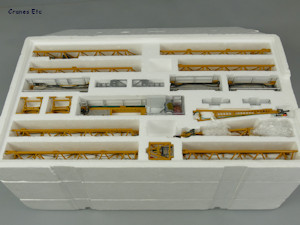 |
| As unpacked, top
tray has the jib and counter jib sections. |
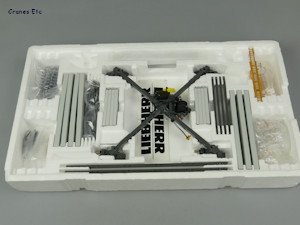 |
| Bottom tray has
the cruciform base and small parts. |
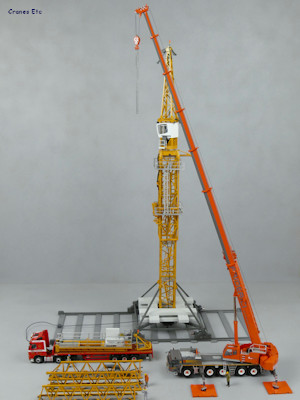 |
| Erection proceeding.
|
|
|
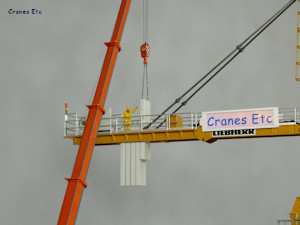 |
| Counterweight slabs
have realistic lifting eyes. |
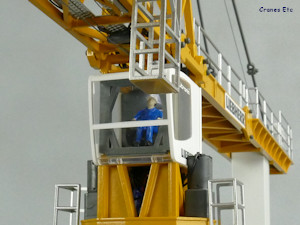 |
| Driver in the cab.
|
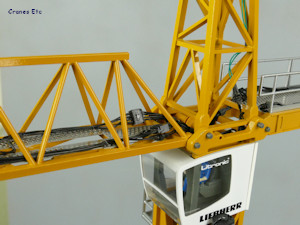 |
| Electric cables.
|
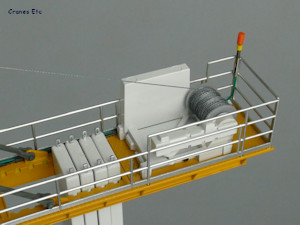 |
| Winch motor is
impressively small. Notches for counterweight slabs
are visible. Warning light at the rear. |
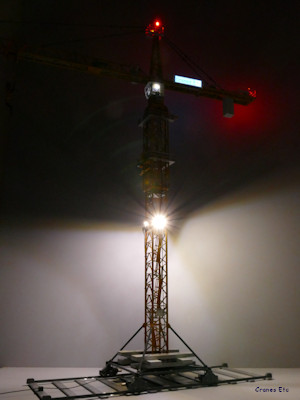 |
| Lights.
Warning, cab, advertising and floodlights.. |
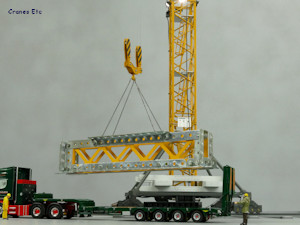 |
| Heavy lift underway
with a double hook. |
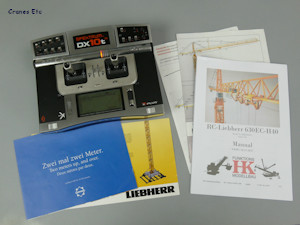 |
| Transmitter and
paperwork. |
|

